A well-formed lighting system provides many advantages for working in a production environment. It helps to increase the labor efficiency of employees of enterprises, minimizes their visual fatigue, and generally provides a favorable environment. To fulfill these conditions, specialists have developed a list of norms and rules that can competently organize light sources. These are the norms of illumination of workplaces and industrial premises, which affect the issues of technical support with devices, sanitary nuances, and also take into account environmental safety requirements.
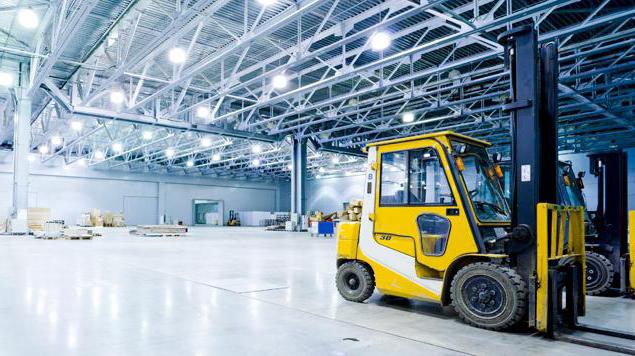
Workplace Lighting Standards
In modern lighting projects, the principles of modeling light are increasingly being used. It allows you to provide volumetric perception of objects, which is very important for employees of enterprises with conveyor lines. Also, this method of organizing light allows you to more accurately calculate the scattering volume and brightness of the radiation supply. In standards, lux (Lk) are taken as the unit of account. One unit of Lx corresponds to one lumen per square meter. So, the general requirements for the illumination of the workplace indicate that in rooms with a constant stay of people, the average lighting value should correspond to 200 Lux. The requirements for uniformity of lighting must be observed. The well-known rule that the light should cover the entire target area, in this case does not work. The workspace is divided into two zones - the periphery and the immediate environment. In the case of the peripheral zone, the uniformity coefficient corresponds to 0.10, and the immediate environment is covered with a value of 0.40. Here, the brightness requirements also differ. The peripheral zone should be illuminated with a calculation of 30 Lux for the ceiling and 50 Lux for the walls.
In organizing the lighting of workplaces, which should have a wide visibility of the surrounding space, the so-called concept of normalizing cylindrical illumination is used. Also, techniques are used to reduce or completely eliminate the degree of reflected gloss. To regulate this parameter, different configurations of the relative positioning of the lamps are used. This allows you to vary the brightness indicators, reflection coefficients of facing materials, etc. Another important question is: what are the requirements for illumination of workplaces in conditions of intense eyestrain? In this case, in addition to observing the brightness of the light, the responsible person should initially correctly approach the choice of lamps. From the point of view of the gentle effect of light on the eyes, it is desirable to integrate incandescent lamps, but due to economic and operational factors this is not always possible. Therefore, special models of fluorescent and LED soft lighting devices are used.
Standards for lighting industrial premises

The idea of an economical, easy to maintain and operate light source is most fully reflected in the requirements for lighting production, technical and storage facilities. The standards recommend the use of discharge devices in the organization of the general supply of light, as well as halogen components and incandescent lamps - while providing local light.In addition to discharge light emitters, for local lighting it is permissible to use incandescent lamps, including low-power ones. Typically, the norms of illumination of workplaces and industrial premises are calculated by the time people spend there. For example, during a short stay of employees, standards reduce the degree of brightness of lighting in relation to the requirements that apply in the case of workplaces. But this applies only to rooms that do not use equipment that requires regular maintenance.
In some cases, combined lighting is allowed. In particular, if the premises of a large area have several functional areas, one of which requires the regular presence of maintenance personnel, and the remaining area remains free. If there are several functional areas in one working room, then it makes sense to organize localized lighting. The degree of intensity when lighting different areas is determined by the nature of the work performed. On average, the lighting rate per 1 sq / m for industrial premises varies from 75 to 300 Lm. That is, the light factor will correspond to the same 75-300 Lx. But this does not mean that this coefficient can be achieved with different lamps, adhering to the same brightness coefficient. Suffice it to say that the same 75 Lm of fluorescent lamp will correspond to 50 Lm of a conventional incandescent lamp.
Organization of natural light
Natural light is not so common in industrial premises compared to artificial light due to the complexity of control and organization. Nevertheless, it is also advisable to use it in order to save and provide visual comfort. Natural light is a must for rooms in which people are constantly present. Exceptions may be due to conflicting technological requirements, as well as the location of such facilities - for example, in the basement floors. In this case, electric lighting is organized, but in the rest rooms natural light should dominate.
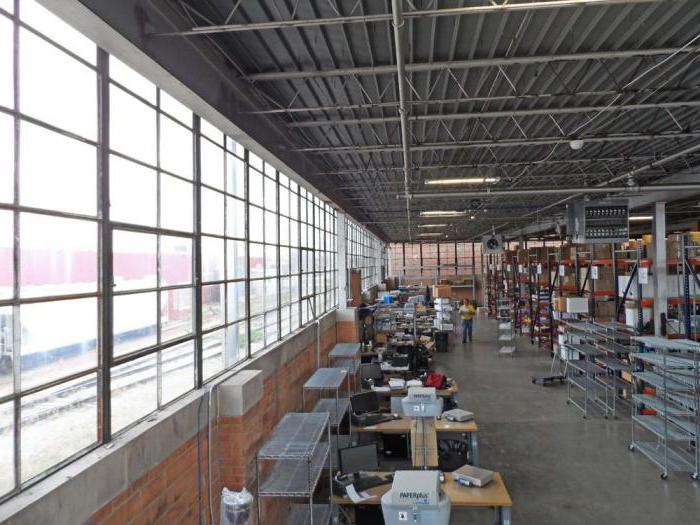
Such light can be top, side and combined. If we are talking about small rooms, then one-sided side lighting with a minimum coefficient is allowed. The optimal solution would be two-way provision of natural light flux. In combination or overhead lighting, an average light factor is required. This rule, in particular, applies to large industrial premises, which also contain partitions, columns and other structural elements that can block the light. Zoned natural lighting of the workplace is rarely dispensed with without incandescent lamps. This is due to the daily change in the brightness of natural light, which has to be replenished in the evening. The effectiveness of visual work is calculated by the ability of the eye to distinguish objects at a distance of up to 50 cm.
Organization of artificial lighting
Artificial light is the main thing at manufacturing enterprises - regardless of whether it is about workplaces or technical and storage facilities. Nevertheless, artificial light is nevertheless subdivided according to functional content. Work, production and special lighting stands out. In each of these cases, general, spot or combined artificial lighting can be organized, in which different methods of technical implementation of the problem are allowed. For example, in the same room the same incandescent lamp can be used to provide visual work on the conveyor line and Armstrong ceiling lights that provide general lighting.

Working artificial lighting in one form or another should be provided for all buildings.In the case of manufacturing enterprises, it will have its own characteristics. Firstly, there are special requirements for the lamps themselves. They must have high-strength housings capable of protecting the direct light source from dust, moisture, dirt and thermal effects. Secondly, they must comply with environmental and sanitary safety standards. In addition, artificial lighting is often the most expensive part in expenditure items for the operation of enterprises. Therefore, modern standards increasingly indicate the need for energy-efficient LED lamps, which are distinguished by a high working resource, and also meet the requirements of brightness and volume of light.
Combined Lighting
This method of organizing lighting is used in cases where natural light is not enough to meet regulatory requirements. That is, we are not talking about the rejection of natural light, but it has to be supplemented with artificial sources. In this case, the main source for general lighting will be artificial light. At the very least, this rule applies to production facilities in which people are constantly present.
In some cases, for such purposes, the use of incandescent lamps is allowed. For example, if the environmental characteristics, the requirements of technological processes and environmental standards do not allow the use of other types of lamps - in particular, discharge lamps. As the norms of illumination of workplaces and industrial premises using a combined scheme indicate, the total light should provide about 200 Lux when using discharge lamps. If incandescent lamps are used in the system, then the illumination can be 100 Lux.
Acceptable Lighting
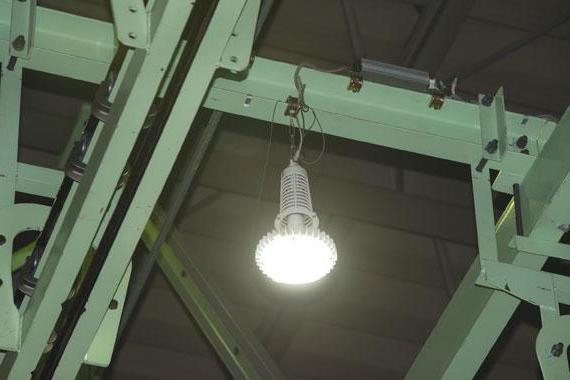
Lighting devices for industrial facilities are selected according to various criteria - from lighting parameters to the requirements of operating conditions. Sanitary standards require that the indicators of glare, light distribution, radiation pulsations, etc., that are optimal for specific operating conditions, be observed. Devices that are designed to be installed in rooms with aggressive environments should have improved insulation coating qualities. The presence of protective dust and moisture resistant shells is mandatory for blacksmith, foundry and concrete mixing plants. Special models are selected for rooms in which there is a risk of fire - for example, this applies to woodworking plants. As for the types of devices, depending on operating conditions, luminaires with fluorescent lamps, LED devices, halogen models and incandescent lamps can be used.
Features of the use of fluorescent lamps
From the point of view of light output, this is one of the most profitable sources, which determined its distribution in the manufacturing sector. Such lamps are able to cover more area, while economically consuming electricity. The rules recommend that they be used as the main sources in general lighting systems. This applies mainly to technical and industrial premises, since workplaces should be serviced by devices that contain a minimum amount of toxic substances. Limitations that prevent the use of luminaires with fluorescent lamps as a universal means of artificial lighting in enterprises are associated not only with the presence of mercury. Over a short period of operation, degradation of the phosphor can be observed, as a result of which the lamp loses paramount brightness. The dispersion coefficient is also reduced, and this problem requires a complete replacement of the device.
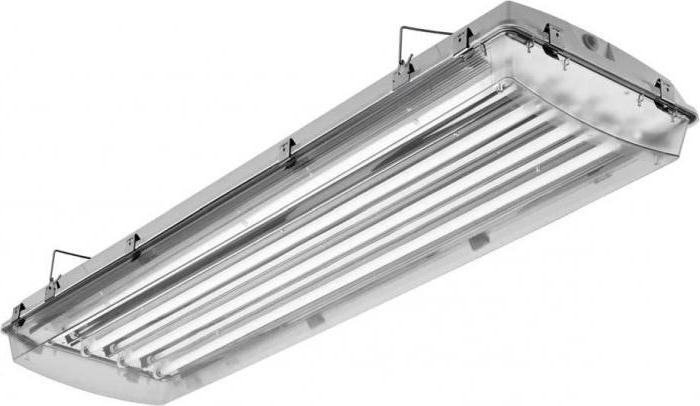
Industry-specific artificial lighting standards
Each area of application of fixtures has its own requirements.So, enterprises of different industries may need different amounts of light. Foundry, thermal, metal, welding and carpentry enterprises in the workshops require an illumination of about 10 lux. Industrial furnaces, in which brick is fired, drying and processing of expanded clay are carried out require the organization of lighting that can give out 5 Lx - that is, 5 Lm per 1 sq / m. Obviously, the norms of illumination of workplaces and industrial premises will also vary depending on the sphere. In particular, areas where personnel are constantly servicing conveyor lines may require a level of illumination of the order of 100-200 Lux. Of course, here is an adjustment for the type of lighting device.
Special Lighting Requirements
Special lighting is designed separately, which includes the illumination of escape routes, emergency devices, etc. For example, emergency lighting of escape routes is used in production rooms where more than 50 people work at a time. As for the degree of illumination, electric lighting can provide about 0.2 Lx in an open area, and 0.5 Lx in complex transitions, steps, etc. At the same time, the entrances and exits from rooms where more than 100 people work should additionally provided with indicator lights.
In hazardous areas, lighting at the level of 0.1 Lux is recommended. Incandescent lamps and fluorescent devices are used to organize light. As noted in the rules of SanPiN, lighting on duty and security posts should be provided within 0.5 Lux. This is provided that in these areas there are no technical means.
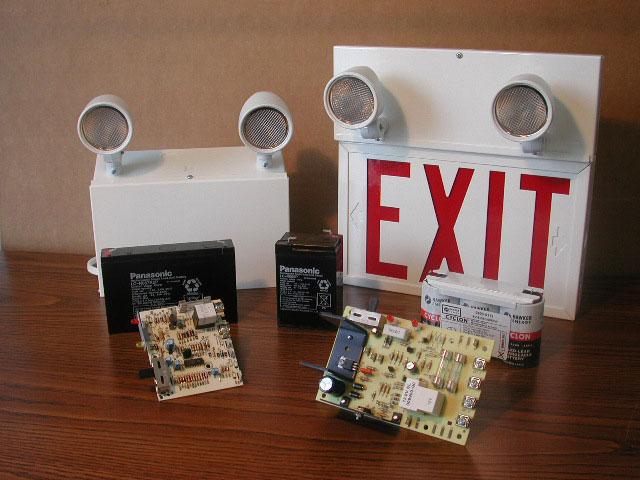
Conclusion
The standards for the organization of lighting in the conditions of production often put conflicting requirements. This is especially true of jobs, the operation of which is really carried out according to strict sanitary and technical rules. For example, lighting rules and regulations require that the daylight ratio should correspond to the complexity of the work performed. Usually it is determined by the size of the objects and details with which the employee works. This rule in most cases can be observed with the help of modern LED lamps. However, the transition to such lighting technology is now impossible for many enterprises due to lack of finance. As a result, individual standards are supplemented by exceptions and alternative ways of organizing light. An example of this is the organization of natural lighting in conditions of limitations associated with the features of the technological process.